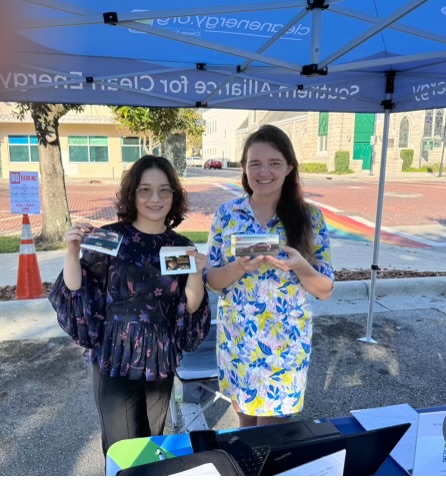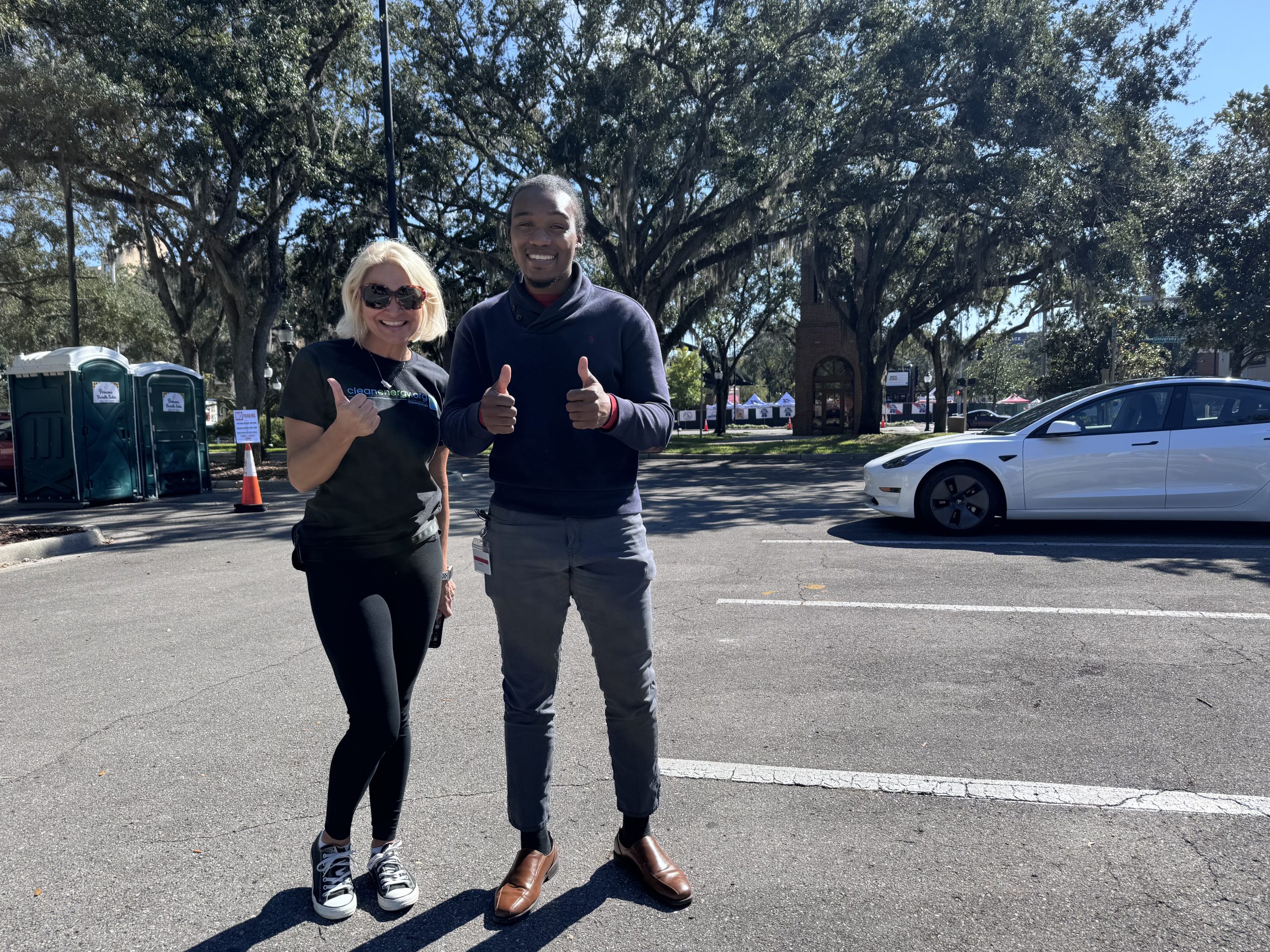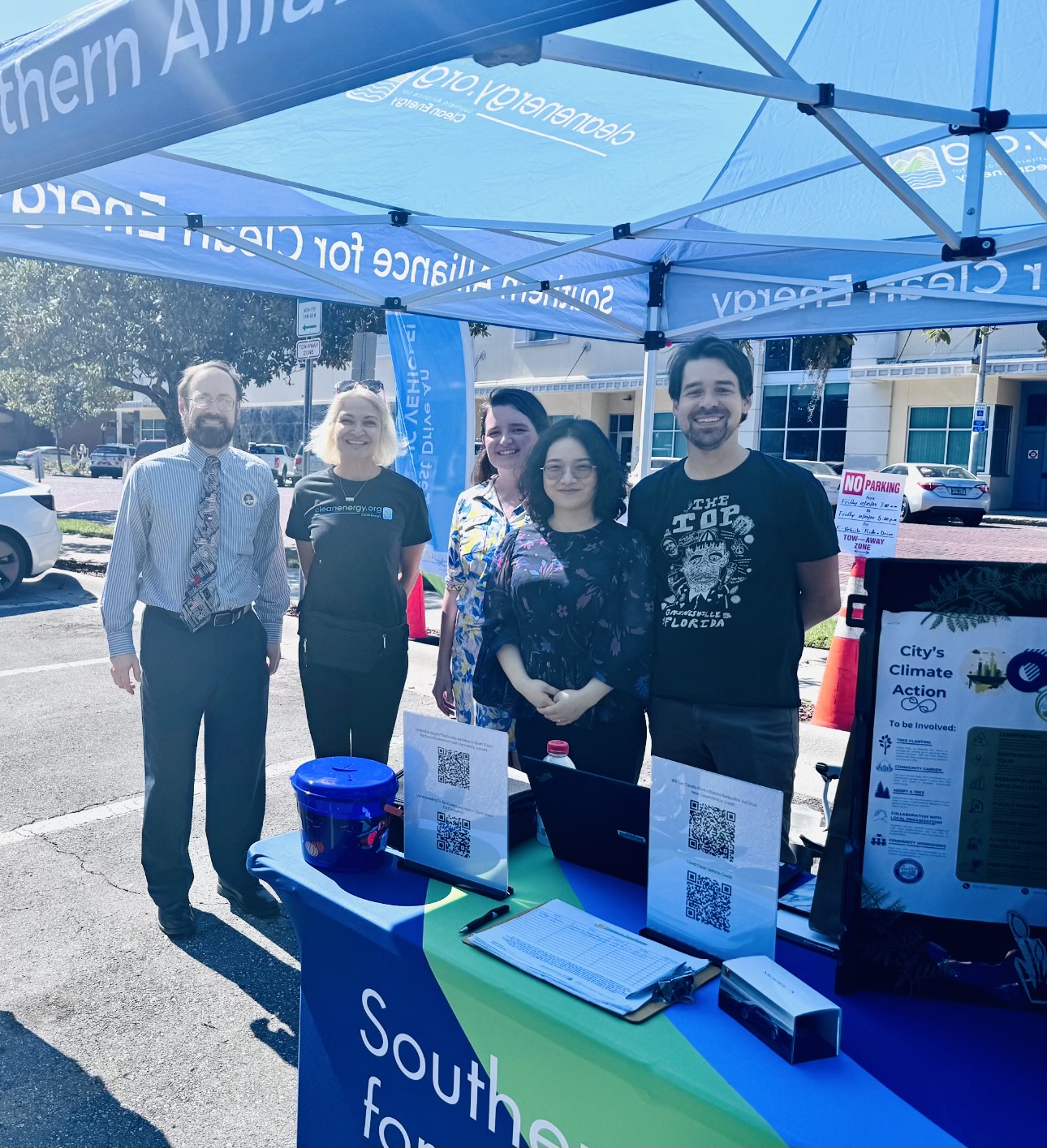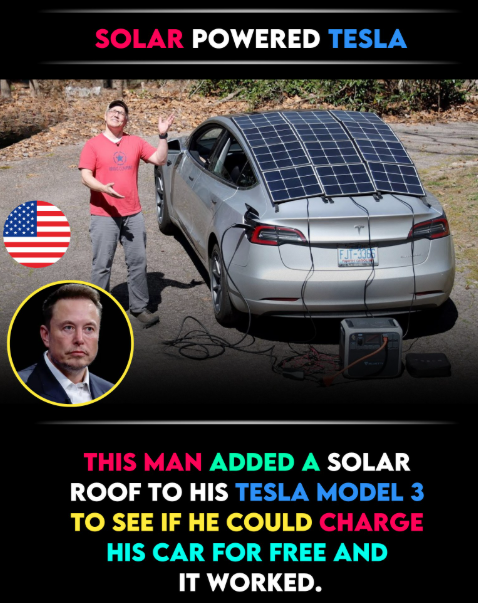 This guest blog was written by Dr. Dan Zhu, Ph.D., LEED GA, Chief Climate Officer with the City of Gainesville, FL; and Jennie Ford, an Environmental Planner with the City of Gainesville’s Department of Sustainable Development.
This guest blog was written by Dr. Dan Zhu, Ph.D., LEED GA, Chief Climate Officer with the City of Gainesville, FL; and Jennie Ford, an Environmental Planner with the City of Gainesville’s Department of Sustainable Development.On Friday, October 25, Gainesville accelerated its commitment to reaching net zero greenhouse gas emissions by 2045 with an electric vehicle (EV) Ride and Drive event hosted in partnership with the Southern Alliance for Clean Energy. This event provided city leaders, elected officials, and staff the unique opportunity to test drive a Tesla Model 3, immersing them in the benefits of EV technology while highlighting Gainesville’s ongoing efforts in transportation electrification. Transportation electrification is a key priority in Gainesville’s Climate Resilience Plan, with the city’s EV Steering Committee hard at work developing a comprehensive plan for electrifying both city and bus fleets, along with public charging infrastructure across the city.
 The test drives offered more than just a thrilling ride—they were an opportunity to learn about the technology directly, with a knowledgeable EV driver in the passenger seat. Dory Larsen, Senior ET Program Manager with the Southern Alliance for Clean Energy, brought expertise and patient guidance to the experience, ensuring participants fully understood the benefits and mechanics of EVs, as well as available tax incentives. Alongside her, city staff shared information on Gainesville’s recent initiatives to increase EV adoption, enhancing participant engagement and bolstering support for the city’s electrification goals.
The test drives offered more than just a thrilling ride—they were an opportunity to learn about the technology directly, with a knowledgeable EV driver in the passenger seat. Dory Larsen, Senior ET Program Manager with the Southern Alliance for Clean Energy, brought expertise and patient guidance to the experience, ensuring participants fully understood the benefits and mechanics of EVs, as well as available tax incentives. Alongside her, city staff shared information on Gainesville’s recent initiatives to increase EV adoption, enhancing participant engagement and bolstering support for the city’s electrification goals.
“Driving a Tesla showcases the remarkable range and seamless technology of electric vehicles—it’s a glimpse into a cleaner, smarter future.”
Participants from various city departments—including Human Resources, Fleet, Public Works, Parks, Housing, Communications and Sustainable Development—joined, as did an elected official, including a representative from the Alachua County and City of Gainesville Joint Water and Climate Policy Board. For many, this was their first time behind the wheel of a Tesla, and the experience was met with enthusiasm and appreciation for the support provided by the Southern Alliance for Clean Energy.
 This event not only fueled excitement around EVs but also reinforced Gainesville’s dedication to creating a sustainable, resilient future for all. Together, we’re embracing a cleaner, greener path forward.
This event not only fueled excitement around EVs but also reinforced Gainesville’s dedication to creating a sustainable, resilient future for all. Together, we’re embracing a cleaner, greener path forward.
“Taking Tesla’s autonomous driving for a spin, we’re showcasing how effortless and impactful the switch to electric vehicles can be for our community and our world.”
The Southern Alliance for Clean Energy’s Electrify the South program leverages research, advocacy, and outreach to accelerate the equitable transition to electric transportation across the Southeast. Visit ElectrifytheSouth.org to learn more and connect with us.
The post Gainesville Embraces Electrification: City Leaders and Staff Test Drive Tesla Model 3 at EV Ride & Drive Event appeared first on SACE | Southern Alliance for Clean Energy.
Renewable Energy
Election Fraud Doesn’t Merit Jail Time? Guess Not
 From “The Grio”:
From “The Grio”:
Austin Smith, a former Republican state representative in Arizona, has pleaded guilty to charges for forging signatures on his 2024 re‑election campaign petitions. He admitted to submitting nomination papers with names of deceased individuals and other forged entries. The plea agreement calls for probation, a fine of $5,000 and a five‑year ban on seeking public office. Meanwhile, Smith had served as a senior director (and briefly strategic director) of Turning Point Action, the 501(c)(4) advocacy arm of the conservative youth group Turning Point USA and resigned from that leadership role when the allegations surfaced. Through his dual role as lawmaker and conservative organizer, Smith’s case underlines questions of campaign integrity and the responsibilities of politically active organizations.
I would have thought (and hoped) that election fraud would merit some jail time.
Renewable Energy
Why Not Behead Dissidents? It Worked for Millennia
 A segment of Newsmax tonight began with many clips from commentators from both parties saying that Donald Trump is the most powerful person in the word. “All right, enough!” the host finally interjected. “Well, if he is the most powerful person in the world, why can’t he appoint whoever (sic) he wants to prosecute James Comey and Letitia James?”
A segment of Newsmax tonight began with many clips from commentators from both parties saying that Donald Trump is the most powerful person in the word. “All right, enough!” the host finally interjected. “Well, if he is the most powerful person in the world, why can’t he appoint whoever (sic) he wants to prosecute James Comey and Letitia James?”
Well, we do have a few sticking points here.
We have the U.S. Constitution, and 200+ years of rule of law, and the concept that no one is above the law.
And we have the question, “Given that they have taken stances against Trump, why not have them both summarily beheaded?” Given that we no longer have a balance of powers among the supposedly three co-equal branches of government, what’s the big deal?
Three hundred years ago, that’s precisely would have happened to people who took public stances against a king.
We either stand for freedom and loyalty to a constitution — or we don’t. We can’t have it both ways.
Renewable Energy
Solar PV on a Car’s Roof
 There is no need to physically attach solar panels to your car’s roof to determine if it will charge your car. Of course it will while it’s in the sun. Let’s do some math:
There is no need to physically attach solar panels to your car’s roof to determine if it will charge your car. Of course it will while it’s in the sun. Let’s do some math:
If:
The area of this Tesla’s roof is 2 square meters (being generous),
The efficiency of the panels is 25%,
The capacity factor of solar (depending on your location) is 20%,
The sun’s irradiance is 1000 watts per square meter,
The Tesla’s battery capacity is 100 KWhrs,
And we neglect the increased weight and drag of the array,
We’re talking about 100 hours, more than 4 days.
Doesn’t sound like a bargain, especially considering that if you overbuild the solar array on your roof and charge your car in your garage, you’ve achieved the same goal at far less expense and inconvenience.
-
Climate Change4 months ago
Guest post: Why China is still building new coal – and when it might stop
-
Greenhouse Gases4 months ago
Guest post: Why China is still building new coal – and when it might stop
-
Climate Change2 years ago
Spanish-language misinformation on renewable energy spreads online, report shows
-

 Greenhouse Gases2 years ago
Greenhouse Gases2 years ago嘉宾来稿:满足中国增长的用电需求 光伏加储能“比新建煤电更实惠”
-
Climate Change Videos2 years ago
The toxic gas flares fuelling Nigeria’s climate change – BBC News
-

 Climate Change2 years ago
Climate Change2 years ago嘉宾来稿:满足中国增长的用电需求 光伏加储能“比新建煤电更实惠”
-

 Carbon Footprint2 years ago
Carbon Footprint2 years agoUS SEC’s Climate Disclosure Rules Spur Renewed Interest in Carbon Credits
-
Renewable Energy5 months ago
US Grid Strain, Possible Allete Sale




